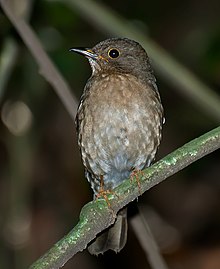Coal thrush
| Coal thrush | ||||||||||||
|---|---|---|---|---|---|---|---|---|---|---|---|---|

Coal thrush ( Turdus flavipes ), male |
||||||||||||
| Systematics | ||||||||||||
|
||||||||||||
| Scientific name | ||||||||||||
| Turdus flavipes | ||||||||||||
| Vieillot , 1818 |
The coal thrush ( Turdus flavipes ) is a songbird species from the genus of the real thrushes ( Turdus ) that occurs in South America . The specific epithet is derived from the Latin words flavus for 'yellow' and pes for 'foot'.
description
Appearance
The coal thrush reaches a body length of about 22 centimeters and a weight of 55.0 to 72.0 grams. There is a slight sexual dimorphism between the sexes . The males' head, chest, back, wings and control feathers are colored black. The arm covers and the stomach are dark gray. The beak, eye ring , legs and feet have a strong yellow color that is slightly paler in the females. The plumage of the females tends to be brownish, with the chest and stomach areas being a little lighter.
singing
The singing is preferably performed from a high place, for example a tree top. It is very variable, very musical, sometimes a bit shrill and consists of a series of loud, melodic and repeatedly repeated phrasings.
Distribution, subspecies and habitat
In addition to the in the southeast of Brazil and Paraguay , as well as in Northeast Argentina occurring nominate Turdus flavipes flavipes four more subspecies known:
- Turdus flavipes melanopleura ( Sharpe , 1902) - in northeastern Venezuela and on Trinidad ,
- Turdus flavipes polionota ( Sharpe , 1902) - in the south of Venezuela, in Guyana and in the northeast of Brazil,
- Turdus flavipes venezuelensis ( Sharpe , 1902) - Colombia and northwestern Venezuela ,
- Turdus flavipes xanthoscela Jardine , 1847 - on Tobago .
The charcoal thrushes colonize moist forests and clearings as well as the fringes of coffee plantations , in areas that extend from the plains to an altitude of 2000 meters, in Venezuela sometimes up to 2500 meters.
Way of life
The birds feed primarily on fruits, occasionally also on insects (Insecta). The fruits and seeds of Myrica or Sloanea species are gladly accepted. In contrast to many other thrush species, they spend little time on the ground. The coal thrushes usually live in pairs. The breeding season was documented differently from region to region between March and July in Trinidad, between September and December in Colombia and between November and January in Brazil. The flat, bowl-shaped nest is made of moss, mud and roots, preferably laid out in rock niches and provided with two eggs. These are pale blue to greenish in color and provided with red-brown speckles. Detailed information on breeding behavior is currently not available.
Hazard and protection
The coal thrush is not uncommon in its areas of distribution and is therefore classified by the IUCN as a ![]() " Least Concern ". Only the subspecies T. flavipes xanthoscela has a very small area of occurrence on Tobago and the population of the number of individuals there should also be carefully documented in the future.
" Least Concern ". Only the subspecies T. flavipes xanthoscela has a very small area of occurrence on Tobago and the population of the number of individuals there should also be carefully documented in the future.
Individual evidence
- ↑ a b c Nigel Collar, Eduardo de Juana, Guy M. Kirwan: Yellow-legged Thrush (Turdus flavipes). In: Josep del Hoyo, Andrew Elliott, Jordi Sargatal, David A. Christie, Eduardo de Juana (eds.): Handbook of the Birds of the World Alive. Lynx Edicions, Barcelona 2017 (accessed at http://www.hbw.com/node/58307 on March 4, 2017).
- ^ IOC Word Bird List
- ^ IUCN Red List
literature
- Josep del Hoyo , Andrew Elliott, David A. Christie: Handbook of the Birds of the World. Volume 10: Cuckoo-shrikes to Thrushes. Lynx Edicions, Barcelona 2005, ISBN 978-84-87334-72-6 .
Web links
- neotropical.birds - Neotropical Birds
- birdlife.org - Bird Life International
- Kohlerdrossel (Turdus flavipes) in the Encyclopedia of Life . Retrieved August 11, 2017.
